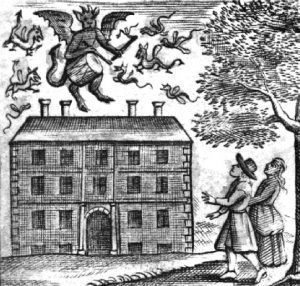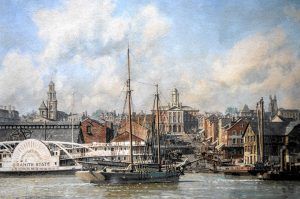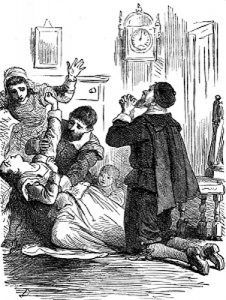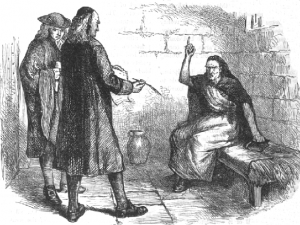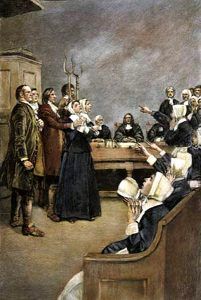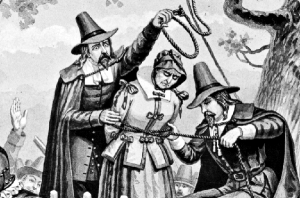Decades before the witch trials began in Salem, Massachusetts, witch hunts were active in Connecticut, lasting intermittently between 1647 and 1697.
This madness peaked in Connecticut in the spring of 1662 with the Hartford Witch Panic, which was set off with the death of eight-year-old Elizabeth Kelly (or Kelley), whose parents were convinced that their neighbor Goody Ayres had caused their child’s death through magic.
The death of Elizabeth Kelly unleashed panic in the Puritan colony Hartford, and in the next year, 10 more ”witches” would be accused, and four of them were put to death.
Two of the accused were Nathaniel and Rebecca Greensmith.
It is unknown where Nathaniel came from or where he was born, but he married Rebecca in about 1655.
Rebecca was born Rebecca Steele in 1629 in Devon, England, to George Steele and Margery Sorrell Steele. Somewhere along the line, she immigrated to America. By the time she met Nathaniel, she had been married twice, the first time to Abraham Elson, with whom she had two children. After Elson died in 1648, she married Jarvis Mudge, with whom she had three children. He died in 1653, and she next married Nathaniel Greensmith. The couple doesn’t appear to have had any children.
The couple lived south of the Little River in Hartford, Connecticut, on some 20 acres of land owned by Nathaniel that had a house and a barn. He also had other holdings on the road leading to Farmington. Nathaniel was not well-liked in the community, perhaps because he had acquired from his neighbors or they were envious. He also had several run-ins with the authorities when he was accused of stealing a hoe, stealing one and a half bushels of wheat, lying in court, and of battery.
Rebecca was also not well thought of as her minister, Reverend John Whiting, described her as “lewd, ignorant and considerably aged.”
Their personal qualities soon elicited the criticism and animosity of the community.
Shortly after Elizabeth Kelly’s death, a young woman named Ann Cole suddenly became “afflicted,” shaking violently and spouting blasphemy. Described as a woman of great integrity and piety, she lived with her father, John Cole, when these events began.
Tormented with doubts about her religious welfare, she talked for hours about evil spirits who were trying to harm her and, at times, lapsed into gibberish. In the presence of two ministers who tried to help her, Ann claimed that a company of familiars of the evil one were conspiring how to carry on their mischievous designs against her. After several hours, Ann began to speak with a precise Dutch accent. Though a Dutch family had recently moved to town, the ministers held that it would be impossible for someone like Ann, not familiarly acquainted with the Dutch, to so exactly imitate their accent. Her fits, which were violent both physically and verbally, happened in public and private.
Cole blamed her bewitchment on her neighbor Rebecca Greensmith.
Before long, there were more people in Hartford who claimed to be possessed, and Ann, as well as two others, had attacks in church. When a special day of prayer was held for them, Ann Cole also denounced Elizabeth Seager, immediately with indignation, calling the accusation nothing but a lot of “hodgepodge.” But Goodwife Miggat added accusations of her own, claiming that Seager had appeared in the night to her, striking her in the face and preventing her from waking her husband before flying away.
In the meantime, Rebecca Greensmith was jailed for suspicion of being a witch. While she was imprisoned, she was interviewed by the Reverends Joseph Haynes and John Whiting. During these interviews, Rebecca confessed that she had familiarity with the devil, that he had appeared to her in the form of a deer, and that she, along with Elizabeth Seager, Mary Barnes, Andrew and Mary Sanford, and William and Goody Ayres, had danced with the devil in the woods. She also implicated James Wakely, Katherine Palmer, and Judith Varlet, who was of the Dutch family that Ann Cole seemingly imitated.
She also went on to implicate her husband, Nathaniel, saying he could do such things as lift heavy weights that even two men could not manage and that he was followed around by wild animals. She also said she was afraid of him because of all the things she had heard about him before their marriage.
A formal complaint was lodged against the Greensmiths on December 30, 1662, and both were indicted for familiarity with the devil. Nathaniel’s indictment read:
“Nathaniel Greensmith thou art here indicted by the name of Nathaniel Greensmith for not having the fear of God before thine eyes, thou hast entertained familiarity with Satan, the grand enemy of God and mankind – and by his help, hast acted things in a preternatural way beyond human abilities in a natural course for which according to the law of God and the established law of this commonwealth thou deservest to die.”
Rebecca’s was likely identical.
In early January 1663, their trial was held at Hartford. Rebecca Greensmith confessed, but her husband, Nathaniel, protested his innocence. The court’s verdict for them both was:
“According to the law of God and the established law of this commonwealth, thou deservest to die.”
In a separate trial, Mary Barnes of Farmington was also convicted of witchcraft at about the same time.
Rebecca and Nathaniel Greensmith and Mary Barnes were hanged on Gallows Hill in Hartford on January 25, 1663.
After all of the accused were dead or gone, Ann Cole recovered. She went on to marry Andrew Benton, a widower with eight children. Twenty years later, the Reverend John Whiting reported that she was still devout and free of fits.
Of the others that Rebecca Greensmith accused, William and Goody Ayres fled, Elizabeth Seager was convicted of witchcraft in 1665, but the governor reversed the verdict the following year; Mary Sanford was found guilty and probably hanged, Andrew Sanford was acquitted, James Wakely escaped to Rhode Island, Judith Varlett was imprisoned and released, and Katherine Palmer was exonerated and sued for slander.
© Kathy Weiser-Alexander, updated April 2021.
Also See:
Salem, Massachusetts Witchcraft Hysteria
Sources:
Guiley, Rosemary, The Encyclopedia of Witches, Witchcraft and Wicca; Checkmark Books, 2008.
Larkin, George Clark, A History of Connecticut: Its People and Institutions, Nabu Press, 2010.
The Other New England Witch Hunt
Taylor, John M.; The Witchcraft Delusion in Colonial Connecticut, 1647-1697; Grafton Press, New York, 1908.
Womens History Blog

